RPM Fluctuating At Constant Speed: 12 Potential Causes
Common causes of RPM fluctuation at constant speed include a dirty air filter restricting airflow, faulty throttle position sensor sending inaccurate signals, vacuum leaks allowing unmetered air to enter and disturb the air-fuel mixture, automatic transmission issues like clutch band slipping from bad fluid, and fuel delivery problems like dirty injectors or a bad regulator. Checking the air filter, throttle sensor, vacuum system, transmission fluid, EGR and PCV valves, injectors, and fuel pressure regulator can help diagnose the root cause. Properly addressing the issue will stabilize RPMs.
Nothing’s more frustrating than inconsistent engine performance when cruising at a steady speed. RPMs jumping up and down when they should stay constant leaves you scratching your head. Why is RPM inconsistent when speed is stable?
In this guide, we’ll walk through some troubleshooting steps to get to the bottom of fluctuating RPM at constant speed and get your engine running smoothly again.
Below, I have briefed the concept of engine’s RPM and its effects on engine’s performance if you rev too high. If you already have preliminary knowledge, you can jump straight to causes section.
If you want to get a quick answer, you can also chat with a virtual mechanic for free.
You can also read my guide on causes of car revving on its own.
- Fluctuating RPM while driving at steady speed is frustrating and can damage the engine.
- Causes include clogged air filter, faulty sensors, transmission issues, worn engine parts, vacuum leaks, bad valves, damaged ignition coils, and clogged fuel injectors.
- Diagnosing the root cause requires methodically checking components like the air filter, sensors, transmission fluid, seals, hoses, and the fuel system.
- Addressing issues like leaks, contamination, electronic faults, or worn parts will restore steady RPM for smooth engine performance.
- Consistent RPM optimizes power delivery, efficiency, drivability and engine longevity.
My Personal Experience With RPM Issues At Constant Speed
Last year, my colleague Dan was having issues with his 2007 Toyota Corolla. He complained that the RPM was fluctuating even when driving at a steady 60 mph on the highway.
After some diagnosis, we discovered his engine air filter was extremely clogged with debris and needed replacing. I removed the old filter and put in a new genuine Toyota air filter. The fluctuation went away and Dan’s Corolla was running smooth again.
Explanation Of RPM and Its Importance
RPM, or revolutions per minute, is a crucial concept in understanding how engines work. In simple terms, RPM refers to the number of times the engine’s crankshaft rotates in one minute.
The crankshaft is part of the engine that converts the linear motion of the pistons into rotational motion, which ultimately drives the wheels of the vehicle. When you start your car, the engine’s RPM is typically around 1,000.
Typically, the higher the RPM, the faster the engine is running, and the more power it is producing.
The RPM of an engine is often controlled by the throttle, which regulates the amount of air and fuel that enters the engine.
The MAF or MAP sensor sends air signals to the ECU to adjust the amount of fuel accordingly. When more air enters the engine, the ECU sends signals to the fuel injectors to inject more fuel to balance the air-fuel ratio.
As you accelerate, the RPM increases, allowing more fuel and air to enter the engine and generate more power. The maximum RPM of an engine depends on various factors, such as its design and the materials used in its construction.
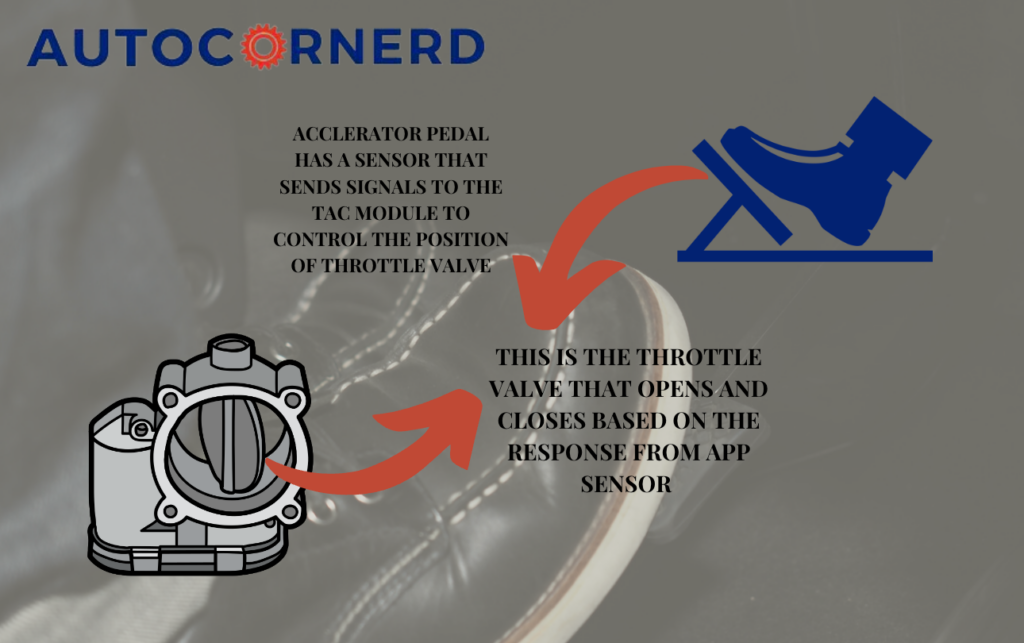
One important thing to keep in mind is that high RPMs can put a lot of stress on an engine. This is why most engines have a redline, which is the maximum RPM that the engine can safely handle.
Going beyond the RPM redline can cause serious damage to the engine, such as a blown head gasket or a thrown rod.
Another factor that affects RPM is transmission. Automatic transmissions typically shift gears at different RPMs depending on the speed of the vehicle, while manual transmissions require the driver to shift gears manually.
Lower gears allow the engine to operate at higher RPMs, providing more power, while higher gears allow the engine to operate at lower RPMs, conserving fuel.
If you continue to drive in low gear, your engine RPM will keep on increasing without increasing the vehicle’s speed. As a result, it will put more stress on the engine, and fuel consumption will also increase.
Modern cars have a tachometer, which displays the engine’s RPM in real-time. If you notice that the RPM is higher or lower than usual, it could be a sign of a problem with the engine or transmission.
Is RPM the Same At Constant Speed?
When driving on a flat road with no wind or load, RPM should remain relatively constant at a given speed.
However, there are several factors that can cause RPM to fluctuate slightly. Let’s discuss them one by one below:
- Uphill Driving: When a vehicle is driven uphill, the force of gravity works against it, requiring the engine to work harder to maintain the same speed. The engine needs to generate more power to overcome the force of gravity, increasing the RPM. The steeper the slope, the higher the RPM required to maintain the same speed.
- Downhill Driving: When going down a hill, the force of gravity works with the vehicle, reducing the amount of power required to maintain the same speed. The engine does not have to work as hard, leading to a decrease in RPM.
- Wind Resistance: The aerodynamic drag caused by wind resistance can impact the RPM at high speeds. The faster the vehicle travels, the stronger the wind resistance, which leads to an increase in RPM as the engine works harder to maintain a constant speed. Similarly, when driving in the opposite direction of strong wind, it could lead to a decrease in RPM as the force of the wind effectively helps the vehicle to move forward, reducing the demand on the engine.
- Changes in Road Surface: Another factor that might cause fluctuation in RPM is changes in the road surface. For instance, driving on a bumpy surface can result in engine speed fluctuation, as it disrupts the wheels’ rotation. This is because the wheels of a vehicle experience inconsistent vertical movement due to uneven terrain, resulting in irregular movement of the vehicle’s suspension system. Similarly, driving on different surfaces such as gravel or loose dirt can also impact the RPM due to the vehicle’s traction issues.
If you are not driving on a hilly road and cruise control is off but still engine RPM is fluctuating, you should troubleshoot the issues I have discussed in the next section.
Causes Of RPM Fluctuating At Constant Speed
Here are the causes of irregular RPM behavior at constant speed:
1. Air Filter Clogging Causes Rapid Changes In Engine RPM
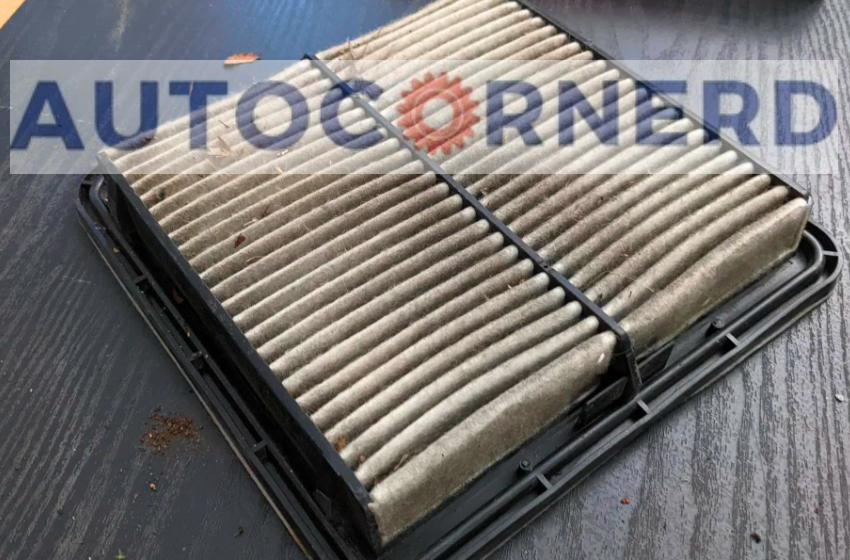
Over time, the air filter gets clogged with dirt and debris, and its ability to filter out contaminants decreases. When this happens, the engine has to work harder to pull in air, and the air-fuel mixture becomes imbalanced.
This can cause a variety of problems, including reduced fuel efficiency, decreased power, and strange engine noises. One of the most common issues that arise from a dirty air filter is changes in RPM despite maintaining speed.
Driving conditions can also affect how quickly an engine air filter becomes dirty. If you frequently drive on dirt roads or in dusty conditions, your engine air filter will become dirty much quicker than if you mostly drive on paved roads.
When you are driving at a constant speed, the engine’s RPM should remain steady. However, if the air filter is dirty, the engine may not be getting enough air, which can cause the RPM to fluctuate.
This is because the engine is not receiving a consistent amount of air, and the air-fuel mixture becomes imbalanced. This, in turn, causes the engine to struggle to maintain a constant RPM and can result in the RPM wavering up and down.
How to fix?
All you need to do is to locate the engine air filter housing which is usually on top of the engine and is secured with clips or screws.
Use a screwdriver or pliers to remove the clips or screws securing the air filter housing cover. Carefully remove the old air filter from the housing and visually inspect it.
One of the easiest ways to tell if your engine air filter is bad is to check its color. A clean air filter should be white or off-white in color, while a dirty air filter will be gray or black. If your engine air filter is extremely dirty, it may even be brown or dark brown in color.
Typically, it is recommended to replace your air filter every 12,000 to 15,000 miles, but this can vary depending on driving conditions. So, if you have driven above 15000 miles without changing an air filter, it is recommended to replace and make sure to get the OEM one.
Furthermore, always blow compressed air through the engine air filter every 1000 miles to keep it fresh.
2. Malfunctioning Throttle Position Sensor Leading to Unstable RPM
The throttle position sensor is a small component located on the throttle body of your engine. Its main function is to monitor the position of the throttle valve and send that information to the engine control module (ECM).
The ECM/ECU uses this information to determine how much air and fuel to inject into the engine to maintain the desired speed.
Now, you might be thinking that the if MAF sensor before the throttle body already measures the amount of air entering the engine and sends signals to the ECU to adjust the fuel supply then why throttle position sensor is needed?
The TPS measures the position of the throttle valve, which is not the same as the amount of air entering the engine. The position of the throttle valve determines how much air and fuel will enter the engine.
The TPS provides the computer with information about the driver’s input, such as when the throttle pedal is depressed, how much, and how quickly. The throttle position sensor provides more accurate information to the ECU about the engine’s operating conditions and allows it to make more precise adjustments to optimize performance and fuel efficiency.
As the accelerator pedal is pressed down, the voltage signal increases, indicating to the ECM that the driver wants to accelerate. The ECM then adjusts the air-fuel mixture and the amount of fuel injected into the engine to increase the vehicle’s speed.
When a TPS malfunctions, it can send incorrect voltage signals to the ECM, causing it to miscalculate the throttle position. This can result in the engine receiving incorrect signals for its air/fuel mixture and ignition timing, which can cause the RPM to fluctuate at a constant speed.
How to test the TP sensor?
If you have Chevy trucks, your scan tool can display the P1516 code. You can read my in-depth guide on P1516 code to get idea about how to fix this code if your Chevy truck is displaying it. For bad throttle position sensors, your scan tool could read P2101, P2175, P0122, P2135 or P0222 codes.
To test throttle position sensors, you have to first check their harness connector through the voltmeter.
After you confirm that the harness connector is fine, connect the black probe of the voltmeter to the engine ground and another red probe to the 5V signal wire of the connector of the TP sensor.
When the throttle body is closed, the voltage will be around 0.2V to 0.9V. As you push the gas pedal and the throttle valve is opened, the voltage should increase to 5V.
3. Slipping Torque Converter Causing RPM Inconsistency
A torque converter is a type of fluid coupling device used in automatic transmissions. It helps to transmit power from the engine to the transmission while allowing the engine to continue running. A torque converter is enclosed in the bell-shaped housing adjacent to the engine.
When the engine is running, the impeller spins, which creates a flow of transmission fluid inside the torque converter. The impeller is welded to the housing of a torque converter so that it rotates with the engine speed.
This transmission fluid flow is directed towards the turbine, causing it to rotate as well. As the turbine spins, it sends power to the transmission and the wheels, allowing your vehicle to move forward.
The turbine and impeller in a torque converter are connected to separate shafts. So, they both rotate independently until the lock-up clutch engages. I have explained this after a few paragraphs.
The stator sits between the impeller and turbine and helps to redirect the fluid flow back towards the impeller, which increases the torque converter’s efficiency.
A torque converter has another important component which is called ‘lock-up clutch‘. This lock-up clutch acts as a mechanical clutch disc in the automatic transmission.
The lock-up clutch is a mechanism that mechanically connects the impeller and turbine, effectively creating a direct connection between the engine and transmission. When the lock-up clutch is engaged, there is no slipping between the impeller and turbine, which improves efficiency and reduces heat generation.
So, basically, when you’re cruising at a fixed speed, the solenoid valve receives a signal from the vehicle’s electronic control unit (ECU) to engage the lockup clutch. The solenoid valve then applies hydraulic pressure to the clutch, which causes it to engage.
When the lock-up clutch engages, it connects the impeller and the turbine, allowing them to rotate at the same speed. This reduces the amount of slippage within the torque converter. The lock-up clutch disengages when the vehicle slows down or comes to a stop, allowing the impeller and the turbine to rotate independently.
So, if the lock-up clutch is slipping, it will cause the torque converter to lock and unlock, resulting in a fluctuation of RPM.
The below 20-minutes video is very helpful to understand the working of a torque converter.
How does torque converter damage?
Several factors can contribute to torque converter failure, including:
- Fluid Contamination: One of the most common causes of torque converter failure is transmission fluid contamination. When the transmission fluid becomes contaminated with dirt, debris, or metal particles, it can damage the torque converter’s internal components. Over time, this can cause the torque converter to fail, leading to rapid fluctuations in RPM.
- Overheating: Another common cause of torque converter failure is overheating. When the transmission system gets too hot, it can cause the transmission fluid to break down, resulting in reduced lubrication and increased wear on the torque converter’s components.
- Wear and Tear: As with any mechanical component, the torque converter can wear out over time due to normal use. The internal components can become worn or damaged, leading to reduced performance and increased RPM changes.
4. Low Transmission Levels Create RPM Changes
The transmission fluid acts as a lubricant, coolant, and hydraulic fluid in your vehicle’s transmission system. It also helps to keep the transmission system cool by dissipating heat that is generated during operation.
A healthy transmission fluid is typically red in color and has a sweet smell. Just like your engine coolant, transmission fluid also flows through a transmission cooler (a part of a radiator) to maintain its temperature and lubrication property.
Transmission fluid also helps to transfer power from the engine to the transmission, which allows the vehicle to move.
Moreover, in the transmission’s valve body, there are electronically-controlled solenoid valves through which transmission fluid flows and exerts hydraulic pressure on clutches and bands to engage gears.
If your vehicle is experiencing low transmission levels, there are several symptoms to look out for. These include slipping gears, delayed shifting, difficulty in accelerating, and loss of power. Since power is related to the engine’s RPM, it will also cause fluctuation in RPM.
When the transmission levels are low, it can also cause the transmission to overheat. Overheating can cause the transmission fluid to break down, which can lead to metal-to-metal contact between the moving parts of the transmission. This can cause damage to the transmission, and it can also cause the RPM to fluctuate at a constant speed.
Furthermore, when there is not enough transmission fluid in your vehicle’s transmission, the torque converter cannot function properly.
The gear pump inside the torque converter may not be able to generate enough pressure to transfer power from the engine to the transmission, which can cause your vehicle’s RPMs to fluctuate at a constant speed.
Why does it happen?
One of the most common reasons for low transmission fluid is leaks. Over time, the seals and gaskets in your transmission system can wear out, leading to fluid leaks.
These leaks can occur in various places, such as the transmission pan, cooler lines, or bell housing. If left unchecked, these leaks can not only result in low fluid levels but also cause damage to other components of your vehicle.
5. Bad Transmission Fluid
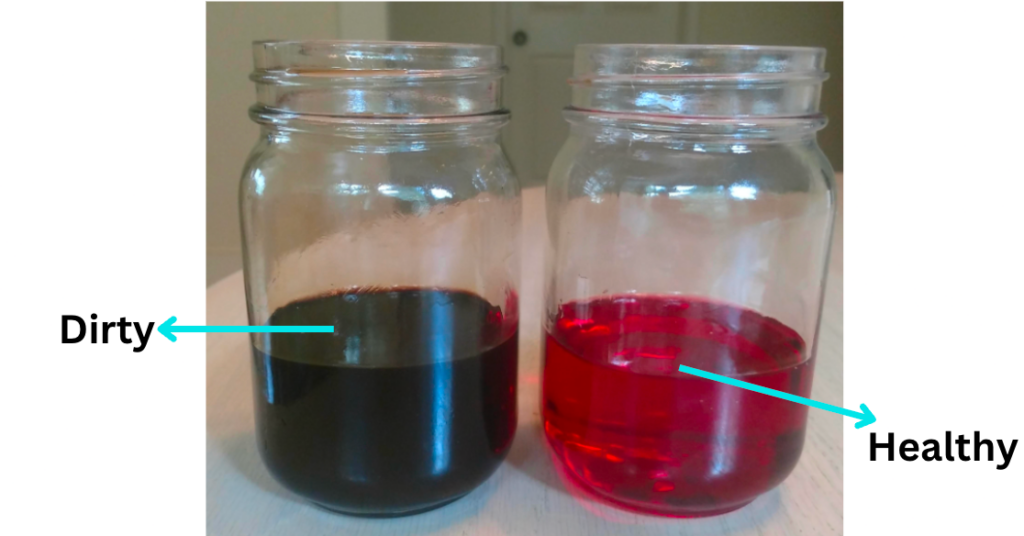
Transmission fluid contains additives that help to keep the transmission system running smoothly.
Over time, these additives can break down, and the fluid can become contaminated with debris and dirt. When this happens, the transmission system can’t operate as it should, leading to issues like variations in engine’s RPM.
Like engine oil, the transmission also has to be changed. However, the interval is a bit longer You have to flush transmission fluid after 60,000 to 70,000 miles.
6. Transmission Valve Solenoids Defects Vary RPM
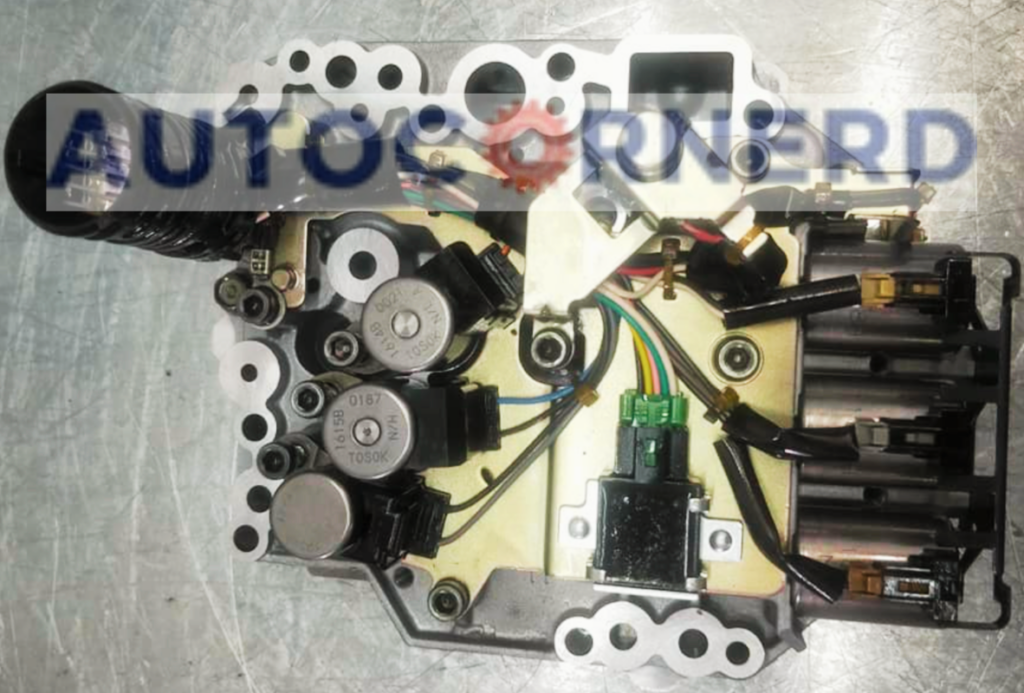
The transmission valve body is essentially the control center for the transmission system. It is a complex assembly of control valves that work together to regulate the flow of transmission fluid through the transmission.
By opening and closing various valves, the solenoids can direct fluid to different parts of the transmission, allowing it to shift gears smoothly and efficiently.
In the below figure, I have shown the valve body and solenoids for Hydra-Matic 4L65-E:

- Transmission fluid pressure switch
- 1-2 shift control solenoid
- 2-3 shift control solenoid
- Pressure control solenoid
When solenoids fail, they can cause a variety of problems in the transmission system. One of the most common symptoms is RPM shifting at a constant speed.
This occurs because the solenoids are not able to control the flow of fluid through the valve body properly. As a result, the transmission may shift gears erratically, causing the engine RPM to fluctuate.
In the valve body, there is pressure solenoid and shift control solenoids. The pressure control solenoid maintains the desired pressure of oil in the valve body. Shift control solenoids are open and closed to direct the oil through the channels in the valve to shift the gears.
You can watch the below youtube video to test the solenoids of an automatic transmission system:
7. Worn Clutches & Bands in Transmission Change RPM

Clutch packs and bands are the components responsible for engaging and disengaging various gears in the transmission.
They are made up of friction material that can wear out over time due to the heat generated by the transmission.
When the clutch packs and bands wear out, they start losing their grip, due to which clutches slip and cause change in RPM.
Diagnosing worn out clutches and bands is quite difficult. However, you may get an idea by checking the condition of magnet inside transmission pan.
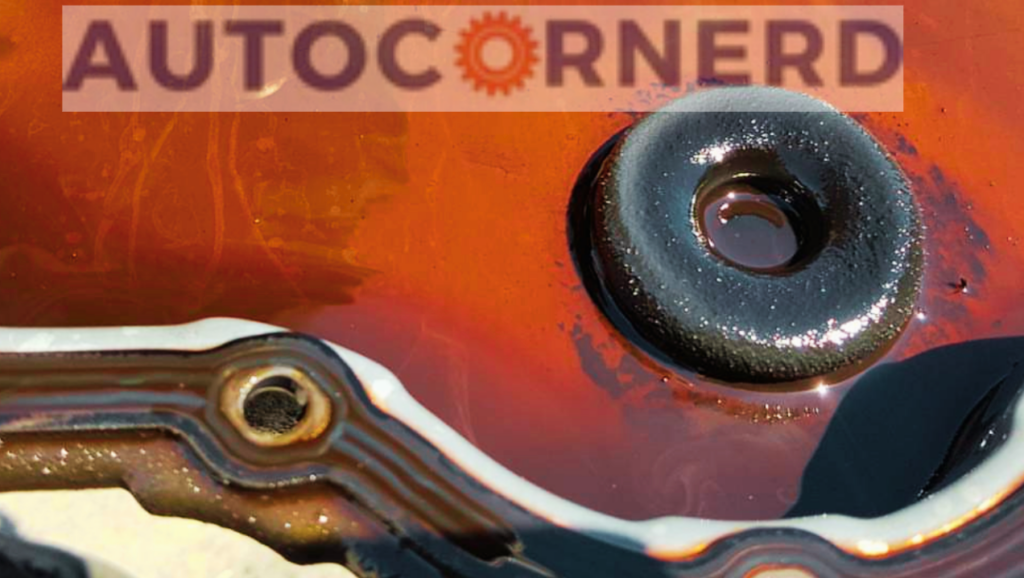
8. Defective EGR Valve Causes Abnormal RPM Behavior
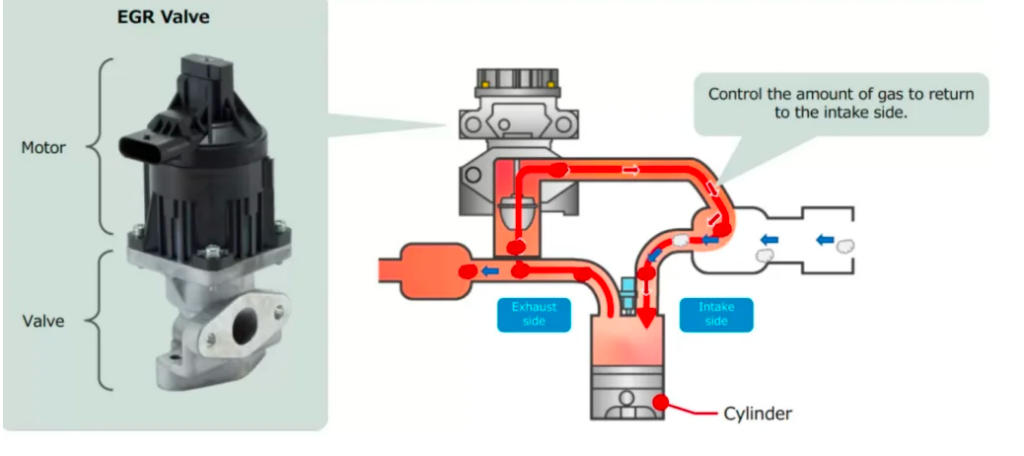
EGR stands for Exhaust Gas Recirculation, and it’s a system that’s designed to reduce the amount of nitrogen oxide (NOx) emissions that are produced by a vehicle’s engine. The EGR valve is a component of this system, and its job is to regulate the amount of exhaust gases that are recirculated back into the engine.
The EGR valve works by diverting a small amount of exhaust gas back into the intake manifold, where it’s mixed with the incoming air/fuel mixture. This mixture then enters the combustion chamber and burns again during the combustion process.
When these exhaust gases are mixed with the incoming air/fuel mixture, they reduce the amount of oxygen available for combustion. This, in turn, reduces the temperature of the combustion process. As a result, less NOx (Nitrogen oxide) emissions are produced.
NOx is a harmful exhaust emission that contributes to pollution and smog. By reducing the amount of NOx emissions, the vehicle becomes more environmentally friendly and can meet strict emissions requirements.
The engine control module decides when to open the EGR valve based on the following factors:
- Intake air temperature
- Position of the throttle valve
- Engine speed
The EGR valve opens under moderate cruising speed and closes when the RPM is too low or high, or under heavy acceleration when full power is needed.
When the engine demands a high load, EGR is off so that the combustion chamber is loaded with more fresh air, and the ignition takes place effectively.
How does the EGR valve get bad?
Over time, carbon deposits can build up on the valve, which can restrict the flow of exhaust gases. This, in turn, can cause the engine to run rough, which can alter the RPM.
If your EGR valve is malfunctioning, the OBDII scan tool will display P0400, P0401 or P0402 error codes.
9. Damaged Ignition Coils Cause Misfires
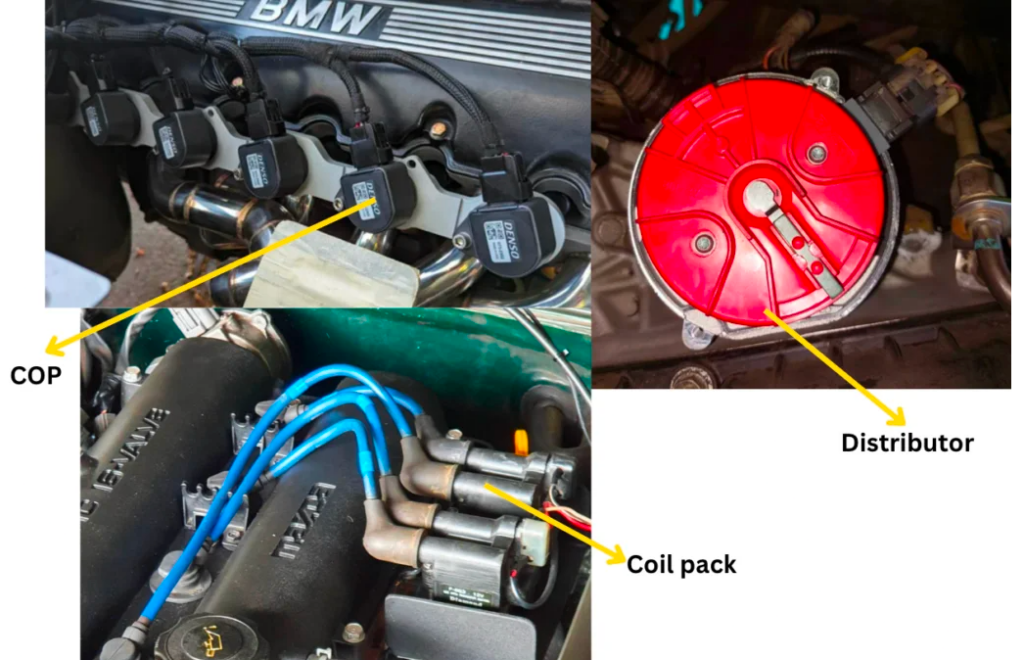
The ignition coil is a transformer that converts the battery’s low voltage (usually 12 volts) into the high voltage (around 20,000 volts) that is necessary to spark the spark plugs and ignite the fuel in the engine.
When an ignition coil becomes damaged, it can cause engine misfires. A misfire occurs when the spark plug does not ignite the fuel in the engine. This can cause RPM fluctuation at same speed, resulting in a rough ride and decreased fuel efficiency.
Moreover, if the ignition coil is damaged, it may produce an inconsistent voltage output. This can cause the spark plugs to fire inconsistently, which can cause the RPM to fluctuate at a constant speed.
Why does it happen?
Bad ignition coils usually cause misfire codes like P0300, P0301, P0302, and P0303. The last digit represents the cylinder number. If the misfire code is P0300, it means that the misfire is occurring randomly in each cylinder. If you want to know, which cylinder in your engine starts from ‘1’. you can read this guide.
How to test?
The only way to test engine misfire is by swapping ignition coils with the one in which misfire is taking place.
If the misfire moves with the coil, then the coil is likely faulty. However, if the misfire stays on the same cylinder after swapping coils, then the issue lies either with the spark plug, injector, compression, or another cylinder-specific problem.
How to fix?
The most common solution to a damaged ignition coil is to replace it with a new one. This will ensure that the engine is receiving the correct voltage and that the spark plugs are firing consistently.
10. Malfunctioning Idle Air Control Valve Alters Engine RPM
The Idle Air Control (IAC) valve is an important component of the engine’s air intake system. Its primary function is to regulate the engine’s idle speed by controlling the amount of air that enters the engine when the throttle is closed i.e. when you have not pressed the gas pedal.
When the throttle is closed, there is no airflow through the engine, which can cause the engine to stall or run roughly. The IAC valve opens a bypass circuit, allowing a small amount of air to enter the engine, which helps to maintain a steady idle speed.
The IAC valve works in conjunction with the engine control module (ECM) to ensure that the engine is idling at the correct speed and that it runs smoothly.
The amount of air entering the engine through the IAC valve is controlled by a small motor that moves a valve inside the valve body.
The ECM receives input from various sensors, including the throttle position sensor, oxygen sensor, and coolant temperature sensor, to determine the engine’s operating conditions.
Based on this input, the ECM sends a signal to the IACV to adjust the amount of air that enters the engine.
You can watch below Youtube video to learn the working of the Idle Air Control Valve:
If an idle air control valve is stuck open, it will allow extra air to enter the engine when a vehicle is moving. It will affect the air-fuel mixture and cause surging in RPM.
How to test?
To check for a malfunctioning IACV, you can first let the engine run at idle. Then, place a finger over the opening located in front of the throttle plate to obstruct it. This action should cause the idle to decrease.
Once you remove your finger, there should be a momentary increase in idle before it returns to its original rate.
This abrupt alteration in RPM is due to the PCM detecting the blocked bypass air port, retracting the IACV, and then permitting air into the bypass port.
This inflow of air leads to the RPMs rising, which is detected by the PCM, resulting in the extension of the IACV to restore the idle to its typical rate. If RPM doesn’t change at all during this step, it means IACV is stuck.
Another way to test IACV is by measuring voltage and resistance across the terminals of its connector using the multimeter. You can watch the below Youtube video for a better understanding.
11. Engine Vacuum Leaks Generate Irregular RPM
When an engine is running, it relies on a precise mixture of air and fuel to operate efficiently. This mixture is achieved through a complex system of valves, sensors, and other components that work together to regulate the flow of air and fuel into the engine.
However, when there is a vacuum leak in the engine, this delicate balance can be disrupted, causing the engine to run poorly and leading to RPM surging.
Vacuum leaks occur when there is an unintended opening in the engine’s air intake system, which allows ‘unmetered air’ to enter the engine at a point where it should not be. This air can cause the engine to run lean, meaning that there is too much air and not enough fuel in the combustion chamber. When the engine is running lean, it can cause a variety of problems, including varying RPMs.
Now, you might be confusing how a vacuum is produced in the engine…
When the engine is running, it creates a vacuum that draws in air, fuel, and exhaust gases. This vacuum is created by the downward movement of the pistons during the intake stroke.
If you are unsure about the term “unmetered air,” it refers to the air that enters the engine cylinder. There is a sensor located before the throttle body, which is either MAF or MAP. This sensor calculates the air amount entering the engine.
However, if the air seeps into the engine from any point beyond the sensor, the sensor will not be able to measure it, nor can it send signals to the ECM.
How to spot?
Here are some of the common ways in which vacuum leaks can occur.
- Worn or Damaged Intake Manifold Gaskets: Intake manifold gaskets are designed to create a seal between the intake manifold and the engine block, allowing air to be drawn into the engine through the throttle body. Over time, these gaskets can become worn, damaged, or brittle, causing them to crack or break. When this happens, air can enter the engine from around the gasket, creating a vacuum leak.
- Loose or Cracked Vacuum Hoses: Vacuum hoses are used to connect various vacuum system components, such as the intake manifold, brake booster, and PCV valve. If these hoses become loose or cracked, they can allow air to enter the engine, creating a vacuum leak.
- Faulty Throttle Body Gasket: The throttle body gasket is located between the throttle body and the intake manifold and is designed to create a seal between the two components. If this gasket becomes damaged or worn, it can allow air to enter the engine without passing through the throttle body, creating a vacuum leak.
- Cracked or Damaged Intake Manifold: In some cases, the intake manifold itself can become cracked or damaged, allowing air to enter the engine without passing through the throttle body. This is a less common cause of vacuum leaks, but it can still occur, particularly in older vehicles or those that have been subjected to extreme temperatures.
- Loose or Damaged Fuel Injector O-Rings: Fuel injectors are responsible for delivering fuel into the engine. They are sealed using O-rings, and if these O-rings become loose or damaged, it can allow air to enter the engine, leading to a vacuum leak.
You can use carb cleaner to detect vacuum leaks in the engine.
12. Clogged Fuel Injectors Provide Inconsistent RPM

A clogged fuel injector can also cause RPM alteration while driving at a steady speed. I won’t explain everything in detail here as it will make this guide too long. You can read my guide on car won’t start after replacing fuel injectors to learn more.
Moreover, you should also check fuel pressure regulator. A bad fuel pressure regulator can’t maintain desired fuel pressure which can also cause RPM oscillation.
Final Thoughts About RPM Fluctuating At Constant Speed
In summary, inconsistent RPM at constant speed is frustrating and detrimental to smooth engine performance. By methodically checking components like the air filter, sensors, transmission, valves, coils, and the fuel system, the root cause can be diagnosed.
Addressing worn parts, leaks, contamination, or electronic issues will restore steady RPM. Proper maintenance and repairs preserve engine efficiency, drivability, and longevity.
Consistent RPM translates to optimized power delivery and ideal combustion. A smooth-running engine minimizes vibration, noise, and component strain. Stabilizing fluctuating RPM enhances the driving experience and maximizes engine life.
Some First Hand Experiences Shared By Users In Different Communities
Our team conducted research across various online communities, forums, and subreddits to gather user comments and opinions on “RPM instability at steady speed”.
User 1 says:
My 2014 Chevy Traverse had a similar problem. The RPMs would jump around at constant speed. After a bit of research and a visit to my mechanic, we figured out it was due to a malfunctioning mass airflow sensor. Cleaning the sensor fixed the fluctuation.
User 2 says
In my Jetta, the fluctuating RPMs were due to a vacuum leak. It was tricky to diagnose, but a smoke test at the mechanic’s shop revealed the issue. Fixing the leak sorted out the fluctuation.
User 3 says:
I own a 2020 Hyundai Sonata, and the RPM fluctuation issue was pretty recent. It turned out to be an issue with the variable valve timing solenoid. Replacing it fixed the problem.
User 4 says:
I faced this issue in my Honda CR-V. After some trial and error, it turned out to be a problem with the transmission fluid. It was low and needed a refill. After the service, the RPMs were steady again.
User 5 says:
I experienced RPM fluctuations in my 2019 Subaru Outback. Initially, I was baffled, but after checking the forums, I learned it might be a software issue. A trip to the dealership for an ECU update solved it.
RPM Fluctuating At Constant Speed: FAQs
Can RPM fluctuation affect the performance of the vehicle?
Yes, inconsistent RPM can affect the performance of the vehicle, including fuel economy, acceleration, and overall engine performance.
Can regular maintenance prevent irregular RPM behavior?
Regular maintenance, such as changing the air filter and spark plugs, can help prevent RPM fluctuations by ensuring the engine is functioning properly.
How do I diagnose RPM fluctuation at a constant speed?
You can diagnose irregular RPM at constant speed by checking the engine for any leaks, inspecting the throttle body and the air intake system, checking the fuel system for any clogs or leaks, and inspecting the EGR valve and the spark plugs.
Can a faulty throttle position sensor cause variations in RPM?
Yes, a faulty throttle position sensor can cause RPM fluctuation as it sends incorrect signals to the engine control unit, resulting in incorrect fuel delivery.
